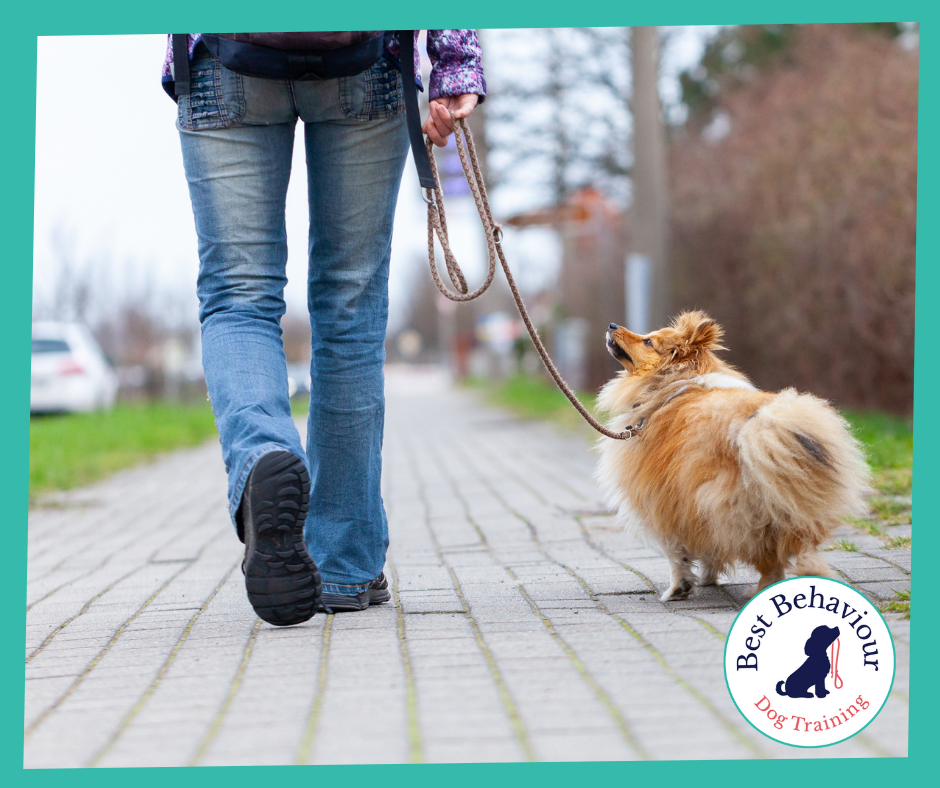Teaching our dogs to walk consistently on a loose lead is probably one of the most challenging training goals faced by many dog owners. It’s equally challenging for our dogs – it takes time for our dogs to develop the ability to focus for an extended period of time, as well as the impulse control needed for them to walk calmly in the presence of the many distractions they may come across on their walks.
I’m sure most if not all dog owners can relate to the frustration and even discomfort or fear that can come with walking a dog who pulls on the lead – from a simple annoyance to a serious safety issue, lead pulling can be a huge problem and really get in the way of us enjoying a pleasant walk with our pups. So, although training our dogs to walk nicely is not the most exciting thing we can spend our time doing, it is well worth the time and effort to do so. It’s also well worth getting started as soon as possible, as our dogs are being rewarded for pulling every time they do so – and practice makes perfect! The longer your dogs practice this behaviour, the harder it will be to undo it!
Below we have covered some of the most important elements to consider when training your dog to walk on a loose lead.
Start at Home
Start working on your loose lead walking in a nice, quiet, distraction-free environment – at home and in the garden are perfect. If we can’t get our dogs walking with us in this environment, it’s going to be impossible to do so once we get out into the big wide world, with all its smells and squirrels!
High Value Rewards
Loose lead walking is a BIG ask of our dogs – we are asking them to manage their excitement and enthusiasm and walk patiently at the same pace as us slow humans! It’s only fair that we make this worth their while, so make sure you bring out the big guns for your training sessions!
High Rate of Reinforcement
The “rate of reinforcement” refers to how often we are offering our dogs a treat. The number one mistake people make when working on their loose lead walking, is to start lowering the rate of reinforcement – ie spacing out the treats – too quickly. It’s important that our dogs learn that by our side is THE place to be and that we are a reliable, trustworthy source of reinforcement. In the long-run, being liberal with our treats in the early stages of training will make it much easier to start rewarding at bigger intervals in the future. If we’re stingy now, our dogs will lose motivation, start pulling on the lead and finding other reinforcers in the environment instead!
Only Increase One Thing at a Time
Whenever we are teaching our dogs anything that we want them to be able to do in different environments, it’s important that we only increase the difficult of one aspect of the behaviour at a time. So, if your dog walks nicely for ten paces at a time between each treat in your garden, start feeding every step of the way when you move out onto the street. You have added a whole host of new distractions – new sights, smells and sounds – which make it much harder for your pup to stay focused and not get distracted. So, make the lead walking easier while they adjust to this new environment! Repeat this process when you move further down the street, when you move into the park, and when you move into the local woodland! As long as you remember to do this, you will be able to progress back to your ten-step interval in each new environment before you know it!
Comfortable Equipment
It’s really important that we make sure our dogs are comfortable, safe and secure when we are walking them. We’re teaching our dogs that walking on a lead with us is a fun and positive thing, and any discomfort cause by our equipment will ruin that by creating unpleasant associations with being on the lead. We recommend a harness with a Y-shaped chest piece, as this will not impede your dog’s movement.
There are numerous bits of kit out there which claim to be “anti-pull,” and we strongly recommend against using these – any piece of equipment which claims to “cure” pulling, does so by making our dogs uncomfortable when they do pull. This might well stop them pulling, but it will increase their stress and anxiety levels, making their walks unenjoyable and potentially creating bad associations with lots of things they come across on walks. If your pup sees another dog, feels excited and momentarily pulls while they are wearing an anti-pull harness or headcollar, this will cause them pain – they may then begin to associate the sight of other dogs with pain and begin to develop fear and reactivity problems.
We also recommend a nice, comfortable training lead and suggest you avoid extendable/retractable leads, as they are both a safety hazard and can promote pulling (find out more by reading our blog about extendable leads, here).
If you need help with you dogs lead waling you can join our lead masterclass here

Copyright © 2024 Best Behaviour Dog Training
Registered No. 12954178
Registered address: Poplar Hill, Stowmarket, Suffolk, IP14 2AX
Website design by Upshot Media Ltd